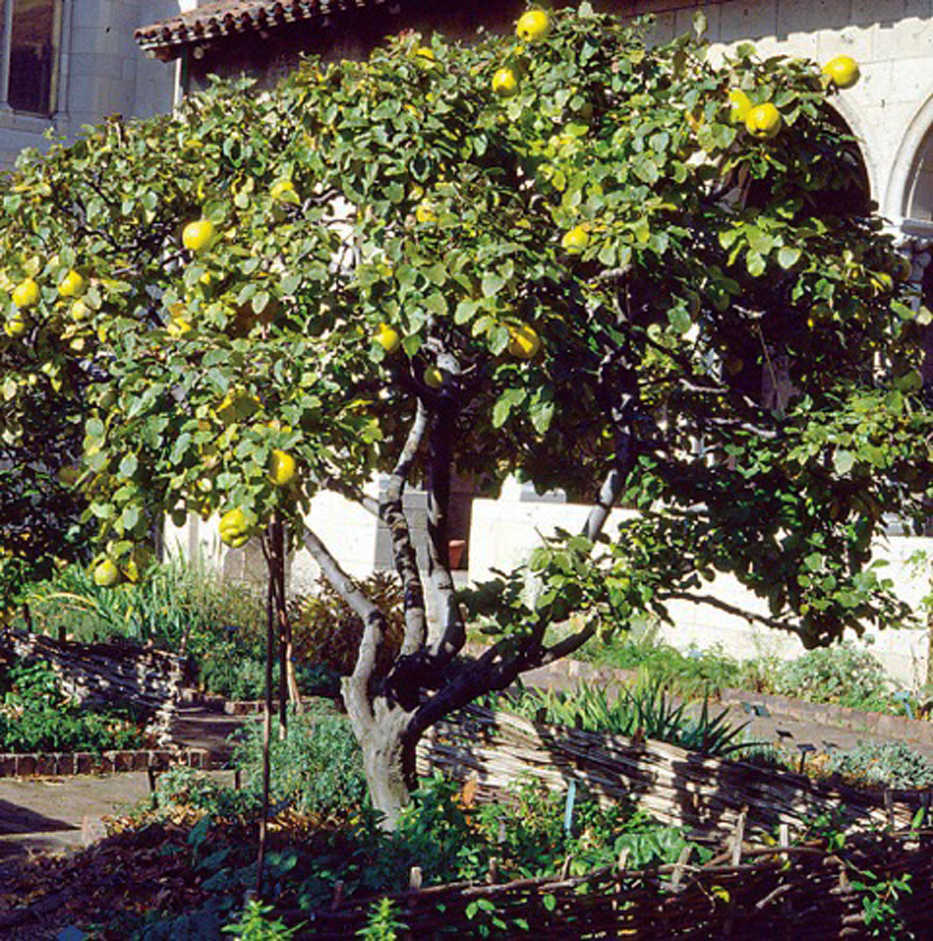In Genesis, the Bible mentions the “forbidden fruit.” Commonly identified as an apple, many people contend it was actually a quince.
The quince’s Mideast origin, as well as its fuzzy, daffodil-yellow skin and a lemony perfume as penetrating as musk make it a strong candidate for the fruit that tempted Adam and Eve in the Garden of Eden.
Don’t take a bite! Fresh, a quince is tart, slightly astringent and dry.
Only after it is cooked — spicing up an apple pie or a batch of applesauce, or on its own in a jelly jar — does quince become its most enticing.
Stewed by itself, the firm, white flesh melts to a smooth, rosy-pink delicacy with hints of pineapple, guava and spice.
Some quince varieties — Aromatnaya and Karp’s Sweet — are said to be edible without cooking, but heat is what really unlocks the best this fruit has to offer in taste, texture and color.
Besides good eating, quince offers two special seasons of beauty. One is now, in autumn, when the stems are festooned with bright fruits shaped like muscular Golden Delicious apples.
In spring, quince’s beauty is more subdued, as white, sometimes pink blossoms unfold. These single blossoms rarely get nipped by frost because they appear relatively late in spring at the tips of new shoots. Growth beyond these flowering shoots is from stems that angle off just behind the flowers to give an old quince tree a craggy, picturesque appearance.
(Don’t confuse this quince, Cydonia oblonga, with the more commonly planted flowering quince, Chaenomeles speciosa, whose usually salmon-pink flowers are followed by green, rock-hard fruits. A combination of long cooking and liberal sweetening renders these fruits edible.)
Although edible quince is not widely planted these days, you can still come upon old trees that were planted decades ago in dank corners of old lots, often the only surviving relics of gardens of the past. Don’t judge quince by the knobby, woody fruit on these neglected plants. Plant quince yourself, give it rich, well-drained soil bathed in sunlight, and you will be rewarded with quinces that ripen to succulent perfection.
Pretty much the only regular care a quince plant needs is light pruning in late winter. When the plant is young, train it either as a small tree with one or a few trunks, or as a many-stemmed, spreading bush. After that, shorten some stems each year and remove some others, enough to keep the plant open to light and air, and to stimulate the foot or two of new growth needed to keep the plant fruitful.
Quince is self-fruitful, so only a single plant is needed for fruiting. The plant offers its first fruits a couple of years after being planted. Besides becoming fully colored, fruits indicate their ripeness by readily detaching from the plant when given a slight upward twist. Although relatively hard, the fruits bruise easily, so handle them with care.
No need to eat them quickly. Ripe, they keep well even at room temperature, ripening more as they sit. On the kitchen counter, they fill the room with spicy fragrance. A traditional way to freshen up a closet or drawer is with a quince fruit stuck full of whole cloves.
Quince is an ancient fruit that long ago made its way west from its original home. The Greeks grew it and dedicated it to their Goddess of Love. According to Columella, a Roman writer of the first century A.D., “Quinces not only yield pleasure, but health.”
Cultivation of the fruit spread throughout Europe and the plants crossed the Atlantic with colonists. Here, quinces were stewed into compote, fermented into wine, and cooked down into a “butter” or into a syrup that once flavored soda-fountain drinks.
As cultivation of quince spread, new varieties originated. Among the more popular are Orange, Pineapple, Champion and Smyrna.
If you enjoy tart fruits, you might actually enjoy biting into the raw fruits of any of these varieties. They do look very enticing.

